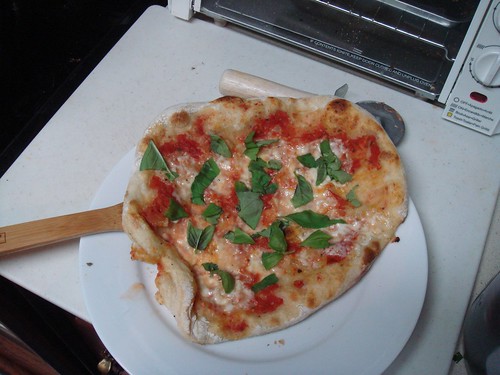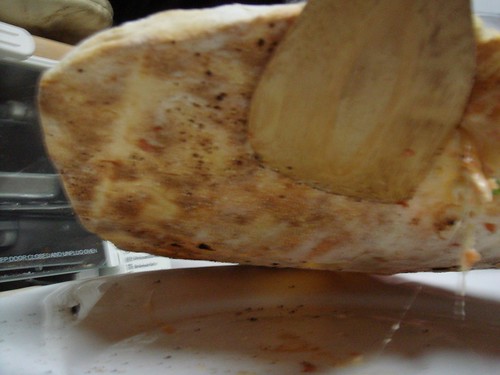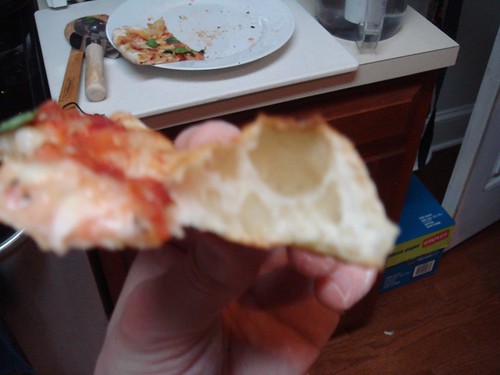Food Experiment: Neapolitan Pizza
Okay, I admit it: I'm turning into a foodie. As if you couldn't tell, we love food, we always have, and we love to cook. One of the things I love is Neapolitan-style pizza, and my favorite pizzeria is 2 Amy's. There is something really lovely about a real margherita pizza: hot, crisp, chewy, the bright tomatoes and basil balanced by creamy fresh mozzarella. 2 Amy's does a real bang-up job of it, and their pizza is certified D.O.C. authentic Neapolitan. If it's certified authentic, it must be good, right? I can't even begin to tell you.
Because 2 Amy's is far away - it's a serious ride on the subway plus about a mile's walk - and because we like to experiment, we decided to try our own version. Without a proper wood-burning oven, our pizza is never going to come out exactly the same as a restaurant's. But we got some good tips from a pizza-making forum.
There were two aspects of our past pizza-making that had to be improved: the crust and the cooking surface. We found a good pizza dough recipe on 101 Cookbooks. This recipe is very sticky and uses overnight fermentation to develop a smooth dough that cooks up with big beautiful bubbles. Some ingenious forum members suggested stacking unglazed quarry tiles instead of a pizza stone in the oven, and making side walls with the tiles to help hold in the heat.
So with the oven cranking along at 550 we made margheritas. It's so simple: pat the dough balls out a little bit, add a little plain tomato sauce, a few bits of mozzarella, and slide the whole thing onto the tiles. (Put the basil on after it comes out of the oven to keep from burning it.) The first pizza slipped onto the hot tiles with a gratifying sizzle.

While the crust turned up a bit and got stuck on this one, it was almost perfect otherwise: good browning, good balance of ingredients, and the crust was crisp in the middle and soft and bubbly at the edges.

This is the bottom of the pizza - while it's a bad, blurry photo, it's the best bottom of a pizza crust I've ever seen come out of a home oven. Browned and crisp without the top burning! Victory!
We stood in the kitchen and slipped pizzas into the oven one by one, eating them as they came out, drinking beer and taking photos. It almost felt a bit decadent, so much fresh food and lovely smells.

Look at those bubbles! That's an amazing texture for homemade pizza.
We considered this a pretty significant triumph, to produce a vastly improved pizza (from previous attempts using a different dough recipe and a metal pan) on our first try. However, there were some things that I want to record for future reference. First of all, we needed a better peel for getting the pizzas into the oven. Getting them back out again was pretty simple, but the sticky dough clung to our parchment paper-covered cardboard. A better dusting of semolina would have helped, and only placing the dough on the peel immediately before dressing it and baking it would have cut down on the sticking. Secondly, the dough that the recipe makes is very wet and sticky - good for pizzas, bad for shaping. The dough has to rest on the counter in thick discs for about 2 hours to warm up before baking. I made the significant mistake of trying to shape the crusts too early - when I went to pick them up again later, they just stretched and stretched until I had a mess of holes and had to roll up the whole thing and start over, which ruined the texture. So the key seems to be leave it alone until it's almost ready to go in the oven, shape the dough, put it on the peel, dress it, slide it.
As with the margherita, simple seems to be best in the end. Tune in next week for another food experiment!
Because 2 Amy's is far away - it's a serious ride on the subway plus about a mile's walk - and because we like to experiment, we decided to try our own version. Without a proper wood-burning oven, our pizza is never going to come out exactly the same as a restaurant's. But we got some good tips from a pizza-making forum.
There were two aspects of our past pizza-making that had to be improved: the crust and the cooking surface. We found a good pizza dough recipe on 101 Cookbooks. This recipe is very sticky and uses overnight fermentation to develop a smooth dough that cooks up with big beautiful bubbles. Some ingenious forum members suggested stacking unglazed quarry tiles instead of a pizza stone in the oven, and making side walls with the tiles to help hold in the heat.
So with the oven cranking along at 550 we made margheritas. It's so simple: pat the dough balls out a little bit, add a little plain tomato sauce, a few bits of mozzarella, and slide the whole thing onto the tiles. (Put the basil on after it comes out of the oven to keep from burning it.) The first pizza slipped onto the hot tiles with a gratifying sizzle.

While the crust turned up a bit and got stuck on this one, it was almost perfect otherwise: good browning, good balance of ingredients, and the crust was crisp in the middle and soft and bubbly at the edges.

This is the bottom of the pizza - while it's a bad, blurry photo, it's the best bottom of a pizza crust I've ever seen come out of a home oven. Browned and crisp without the top burning! Victory!
We stood in the kitchen and slipped pizzas into the oven one by one, eating them as they came out, drinking beer and taking photos. It almost felt a bit decadent, so much fresh food and lovely smells.

Look at those bubbles! That's an amazing texture for homemade pizza.
We considered this a pretty significant triumph, to produce a vastly improved pizza (from previous attempts using a different dough recipe and a metal pan) on our first try. However, there were some things that I want to record for future reference. First of all, we needed a better peel for getting the pizzas into the oven. Getting them back out again was pretty simple, but the sticky dough clung to our parchment paper-covered cardboard. A better dusting of semolina would have helped, and only placing the dough on the peel immediately before dressing it and baking it would have cut down on the sticking. Secondly, the dough that the recipe makes is very wet and sticky - good for pizzas, bad for shaping. The dough has to rest on the counter in thick discs for about 2 hours to warm up before baking. I made the significant mistake of trying to shape the crusts too early - when I went to pick them up again later, they just stretched and stretched until I had a mess of holes and had to roll up the whole thing and start over, which ruined the texture. So the key seems to be leave it alone until it's almost ready to go in the oven, shape the dough, put it on the peel, dress it, slide it.
As with the margherita, simple seems to be best in the end. Tune in next week for another food experiment!
Comments